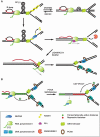RECQ5: A Mysterious Helicase at the Interface of DNA Replication and Transcription
- PMID: 32098287
- PMCID: PMC7073763
- DOI: 10.3390/genes11020232
RECQ5: A Mysterious Helicase at the Interface of DNA Replication and Transcription
Abstract
RECQ5 belongs to the RecQ family of DNA helicases. It is conserved from Drosophila to humans and its deficiency results in genomic instability and cancer susceptibility in mice. Human RECQ5 is known for its ability to regulate homologous recombination by disrupting RAD51 nucleoprotein filaments. It also binds to RNA polymerase II (RNAPII) and negatively regulates transcript elongation by RNAPII. Here, we summarize recent studies implicating RECQ5 in the prevention and resolution of transcription-replication conflicts, a major intrinsic source of genomic instability during cancer development.
Keywords: DNA repair; R-loops; RECQ5; genomic instability; replication stress; transcription-replication conflicts.
Conflict of interest statement
The authors declare no conflict of interest.
Figures



References
Publication types
MeSH terms
Substances
LinkOut - more resources
Full Text Sources
Research Materials

